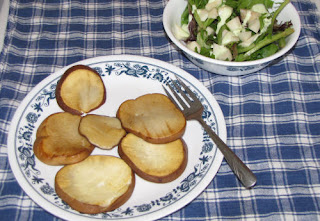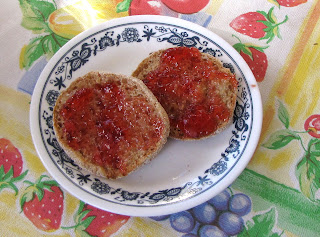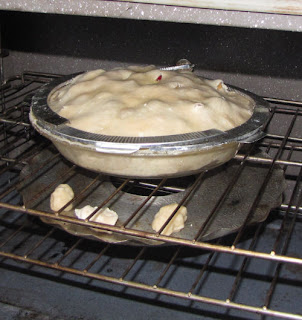 seven quarts in a canner (photo by jhy) seven quarts in a canner (photo by jhy) |
You will need: see
Equipment Needed for Hot Water Bath Canning
What is Hot Water Bath Canning?
Canning your own food to preserve it can be very satisfying, and it's a great way to work at becoming more of a locovore. However, if you have not done this before, the whole process can seem daunting. Trust me, even though there are a lot of steps, the basics remain the same for any recipe, so you will quickly become adept at the job. There is a lot of cleanup, and rustling of large pots and pans. None of us can do anything about that!
Processing by the hot water bath method means to submerge jars of hot food in boiling water, and keep them at the boiling point for a specified length of time (stated in individual recipes). This raises the temperature of the food in the jars high enough that bacteria is killed. When special types of lids are used, which seal when the jars cool, food can be kept without spoiling for years (although color and texture may change with age).
Hot water bath processing is suitable for fruits and acid vegetables. Other foods need to be processed in a pressure canner which will raise the temperature higher than 212 F (100C). In general beans, corn, meats, and any low-acid food requires pressure canning, or the bacteria will not be destroyed. Don't take chances with this, because home-canned food can kill if botulism is present.
Steps Used for any Recipe
Don't prepare more food at one time than you can process in one canner load. It's fine to do fewer jars, though; the canner does not have to be full.
You have to do some multi-tasking here. Somewhere between steps 1 and 5 you have to get the food ready that's going in the jars. You want the water in the canner to be hot and ready to receive the jars of food. You don't need to be boiling empty jars for an hour, but you do want to be sure they are hot and sterile when you need them. I usually do step 1, get the water for step 4 ready and warmed up, then hold it just under a boil until I'm almost ready for the jars.
1. Wash canning jars thoroughly. Check the rims for any nicks, or scratches; these jars probably won't seal. Never use a jar with a crack- it's sure to break.
2. Fill the canner at least half full of water, and put the rack in it. Begin heating this. It's good to have it just below the boiling point when the jars of food go in. It takes a long time to heat this much water, so that's why I put this as step 2. You should also fill another kettle, teakettle, etc with water and bring it to a simmer, too. When you have the jars in the canner, you'll probably need to top it off, and you should do this with hot water.
 canning lids soaking (photo by jhy) canning lids soaking (photo by jhy) |
3. Put lids to soak in a shallow dish of clean, warm water. This softens the sealing material slightly. I usually alternate them, one up, one down, so I can easily grab them when needed. If they are all stacked one way they can be difficult to separate when I'm in a hurry to get one on the jar.
4. Place clean jars in a kettle of simmering water, laying on their side. They don't have to be completely submerged, but be sure that the water is boiling enough to produce what my mother used to call "live steam." If you can only fit a couple of jars in your kettle at a time, that's fine. They only need one minute in the boiling water/steam to sterilize them. You can be sterilizing the next one while you are filling a jar with food.
 1/2 inch headspace (photo by jhy) 1/2 inch headspace (photo by jhy) |
5. When the food is ready, put a towel on the counter or table. This insulates and cushions the hot jars so they are less likely to break when contacting the surface. The chances of that happening are slim, but I've had it happen once with a jar full of hot tomatoes, and it was no fun at all. I suspect that jar had a crack I didn't notice. Fill the jar with the food leaving the amount of headspace indicated in the recipe. Headspace just means the distance from the top of the liquid to the rim of the jar. Depending on the food, a canning funnel can be really useful for this job.
6. Using a very clean damp cloth, or a damp paper towel (I prefer this as I can always have a clean spot), wipe the rim of the jar to remove any drips. Even one grain of sugar can prevent a jar from sealing. Do this carefully.
7. Take one of the wet lids and place it on the jar with the sealing compound against the rim.
8. Screw a band on the jar to hold the lid in place. Tighten it snugly, but not forcefully.
9. Place the jar of food in the canner. The rack will keep it from touching the bottom of the canner, and will also hold it upright. Repeat steps 5-9 until the canner is full or you have used all your food. If there is some food left over, just refrigerate and use soon. Partially filled jars won't seal.
10. Top off the water in the canner. Jars should be covered with at least a half inch of water. Bring the water in the canner to a boil. It does not need to be a full rolling boil, but needs to really boiling, not just producing occasional air bubbles.
11. Boil (process) for the recommended time in the recipe.
12. Turn off the heat and remove jars from the canner. It's possible to do this by lifting out the rack to remove all the jars at once, but I'm always concerned that I'll jostle or drop them, so I use my jar lifter and remove them one at a time. Place them on the towel again, and don't let them touch. In fact, keep them at least an inch apart so that the cooling takes place evenly.
13. Wait at least 12 hours. In fact, my mother always said to not even move the jars for a day.
| 14. Remove the rings. Wash the outsides of the jars. Particularly if the contents were sugared, some syrup is likely to have oozed out during processing and made them sticky. Label- don't think you'll easily remember what's in the jars. A lot of things look a lot alike after a few years on the pantry shelf. Unless it's for a gift, I just use a marker and write on the cap. Be sure to include the year! This way you can use the oldest jars first. It's also handy for reference if one batch turned out particularly good or bad.
15. Clean up the whole mess, and start another batch of something! |

 puffball and stir-fried veggies (photo by jhy)
puffball and stir-fried veggies (photo by jhy) 


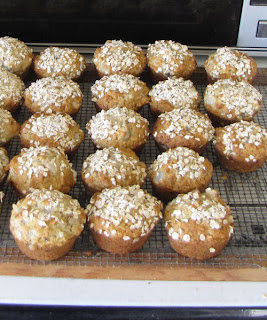





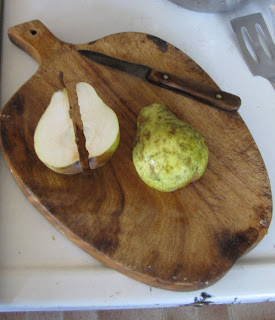



 Then I discovered that I didn't have any whole allspice. I substituted a teaspoon of ground allspice, and it worked fine. The spices need to be tied in a square of cloth. I used a clean piece of old cotton jersey knit. Muslin would be good too. I fastened it with a rubber band instead of string, and that seemed to work fine.
My recipe said to run the apples through with a needle to prevent them from bursting. I used a large corsage pin to do this, and put two holes through each one.
Combine the sugar, vinegar and water, add the spice bag and boil for 5 minutes. Then you want to cook the apples in this hot mixture. They should be cooked only one layer at a time. You could ladle them in and out with a slotted spoon. I have a basket that fits in a gallon kettle, and I used that which made it easy to gently lift the apples in and out of the hot syrup. However, the directions I have only say to cook gently until the apples are almost tender.
Then I discovered that I didn't have any whole allspice. I substituted a teaspoon of ground allspice, and it worked fine. The spices need to be tied in a square of cloth. I used a clean piece of old cotton jersey knit. Muslin would be good too. I fastened it with a rubber band instead of string, and that seemed to work fine.
My recipe said to run the apples through with a needle to prevent them from bursting. I used a large corsage pin to do this, and put two holes through each one.
Combine the sugar, vinegar and water, add the spice bag and boil for 5 minutes. Then you want to cook the apples in this hot mixture. They should be cooked only one layer at a time. You could ladle them in and out with a slotted spoon. I have a basket that fits in a gallon kettle, and I used that which made it easy to gently lift the apples in and out of the hot syrup. However, the directions I have only say to cook gently until the apples are almost tender.
 I tried 5 minutes, and that was way too long. Almost all of the apples split, like the one you see here. I wasn't very happy, but decided that I cooked them too long. I reduced the cooking time to just under 2 minutes. Some of the apples still split. As it turned out the inner fruit took on the deep red color of the skins, so the splits didn't show very much, but if you were making these for gifts, you might want to sort the apples after cooking to choose ones that didn't split.
As each batch of apples is cooked, remove it carefully from the syrup and put in a clean pan. When all the apples are cooked, pour the hot syrup over all the apples. Cover. Put them in the refrigerator for 12-18 hours.
I tried 5 minutes, and that was way too long. Almost all of the apples split, like the one you see here. I wasn't very happy, but decided that I cooked them too long. I reduced the cooking time to just under 2 minutes. Some of the apples still split. As it turned out the inner fruit took on the deep red color of the skins, so the splits didn't show very much, but if you were making these for gifts, you might want to sort the apples after cooking to choose ones that didn't split.
As each batch of apples is cooked, remove it carefully from the syrup and put in a clean pan. When all the apples are cooked, pour the hot syrup over all the apples. Cover. Put them in the refrigerator for 12-18 hours.








